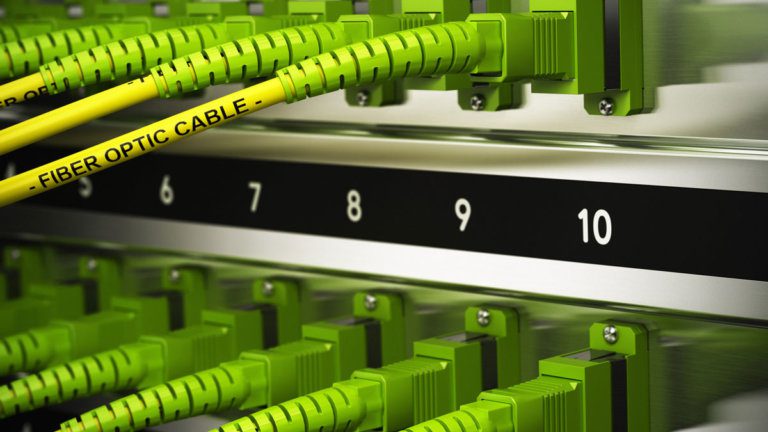Networks
Keeping Pace with Nielsen’s Law

The telecommunications industry typically uses Nielsen’s Law of Internet Bandwidth to represent historical broadband Internet speeds and to forecast future broadband Internet speeds. Mr. Nielsen predicted many years ago the high-end user’s downstream connection speed grows by approximately 50% compound annual growth rate (CAGR). In reality, actual peak service tiers offered by service providers over the years may be following something closer to 60% compound annual growth rate, as shown in the figure below.
The point of this blog is not to debate whether the growth rate is 50% or 60%, but rather if the growth rate continues, how do we evolve our networks to keep pace?
For point-to-multipoint networks there is a general rule of thumb for determining the peak service tier given a particular peak network capacity. This capacity-to-peak-tier ratio of 2:1 isn’t necessarily based in scientific fact, but comes from years of experience that a 2:1 ratio allows service providers to have a reasonable level of confidence that speed test measurements will accurately reflect a user’s subscription level. For example, for a particular access network technology, if the network supports 2 Gbps transmission rates to/from the access termination device (i.e., a cable modem) then the peak service tier typically won’t exceed 1 Gbps.
The present state of the art access network technology peaks at 10 Gbps[1]. The IEEE 802.3 10 Gbps Ethernet Passive Optical Network (10G-EPON) has been deployed in China and the United States. ITU-T has recently consented XGS-PON, another 10 Gbps symmetric PON standard that uses the physical layer of XG-PON (ITU-T G.987.2) and 10G-EPON. Even the ITU-T’s NG-PON2 standard, which uses multiple wavelengths to increase network capacity, only defines a single wavelength per optical network unit (ONU), which puts NG-PON2 on par with 10G-EPON and XGS-PON in terms of meeting peak service tier rates. Finally, CableLabs is now certifying DOCSIS 3.1 devices which are capable of 10 Gbps downstream, and soon will certify 10 Gbps symmetric devices based on Full Duplex DOCSIS technology. What does this mean for accommodating Nielsen’s Law? Assuming the peak service tier trends continue, and given the 10 Gbps peak network capacity of current solutions, the maximum peak service tier will level off at approximately 5 Gbps (see red dashed line in chart above) until technology advances to allow higher rates. The telecommunications industry needs a technology roadmap beyond the current state of the art which allows for peak service tiers to exceed 5 Gbps.
CableLabs and its members, along with other service providers and the IEEE, are determined to stay ahead of the trends displayed in the graph above by contributing to the world’s first 100 Gbps EPON solution as part of the IEEE 802.3ca Task Force. The prevailing sentiment of the 802.3ca Task Force is to create a generational standard that allows for growth of peak network capacity (and corresponding peak service tiers) if and when such growth becomes necessary, without creating a new standard. This growth is expected to be achieved through defining four wavelengths, with each wavelength supporting 25 Gbps. Initial product developments will revolve around a single wavelength to provide a 25 Gbps EPON solution. When market conditions demand it, using two wavelengths along with a channel bonding solution will allow an ONU to transmit and receive at up to 50 Gbps. Similarly, with four wavelengths and channel bonding the ONU will transmit and receive at up to 100 Gbps. Examining the chart above, and assuming historical trends continue, the reader can see the 100G-EPON standard will support peak service tiers out to approximately 2030, give or take a couple years, assuming the 50% CAGR predicted by Nielsen continues.
One of the interesting facets of the 802.3ca Task Force activities relates to the improvement in efficiencies in the media access control (MAC). Previously, the IEEE 802.3 standard did not allow frame fragmentation, but recently with the completion of the IEEE 802.3br Interspersing Express Traffic Task Force, frame fragmentation is now allowed in networks based on the 802.3 standard. The 802.3ca Task Force plans to leverage fragmentation to make transmission more efficient in a multi-wavelength, channel-bonded environment. Additionally, contributions to the 802.3ca Task Force will improve the efficiency of the upstream bandwidth allocation process by allowing multiple service flow queue depth reporting and upstream granting in a single message pair. Considering the ITU-T SG15/Q2 is also investigating 25 Gbps per wavelength, the more promising and exciting aspect of these 802.3ca Task Force decisions is that the next generation of IEEE EPON and ITU-T GPON standards could be more closely aligned than ever before in the very near future! This makes a converged optical access solution closer to reality. (see a previous blog regarding a converged optical access initiative)
In his role as Vice President Wired Technologies at CableLabs, Curtis Knittle leads the activities which focus on cable operator integration of optical technologies in access networks. Curtis is also Chair of the IEEE 802.3ca Task Force.
[1] I’m ignoring point-to-point fiber solutions such as Active Ethernet because these are not typically residential solutions.


